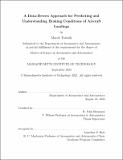A Data-Driven Approach for Predicting and Understanding Braking Conditions of Aircraft Landings
Author(s)
Trávník, Marek
DownloadThesis PDF (4.773Mb)
Advisor
Hansman, R. John
Terms of use
Metadata
Show full item recordAbstract
Traditional runway condition reporting is limited due to its reliance on runway contamination information and pilot reports of braking action. A database of 4.9 million aircraft landings by Aviation Safety Technologies, labeled with runway condition codes computed from aircraft sensor outputs provides a unique opportunity to enhance
and modernise condition reporting using data-driven methods.
This thesis presents an ensemble model trained on this landing database to predict runway condition codes using a cascading Xgboost architecture. The method uses a novel multiple ROC threshold setting procedure for linked classifiers which maintains
the shape of the runway condition code distribution. A forecast-focused version of the model only requires weather information from METAR reports, a description of the runway and aircraft type as input. The method is validated on a collection of 30 historical runway excursions, assigning at best "Medium to Poor" braking action to
all cases with reduced friction. Feature importance is computed using SHAP values, showing that relative humidity, temperature, precipitation, and aircraft type are the features that guide model predictions the most.
The model can be used to create decision aids for aircraft operators, to complement traditional condition reporting, and/or as a forecasting tool to inform runway maintenance decisions.
Date issued
2022-09Department
Massachusetts Institute of Technology. Department of Aeronautics and AstronauticsPublisher
Massachusetts Institute of Technology